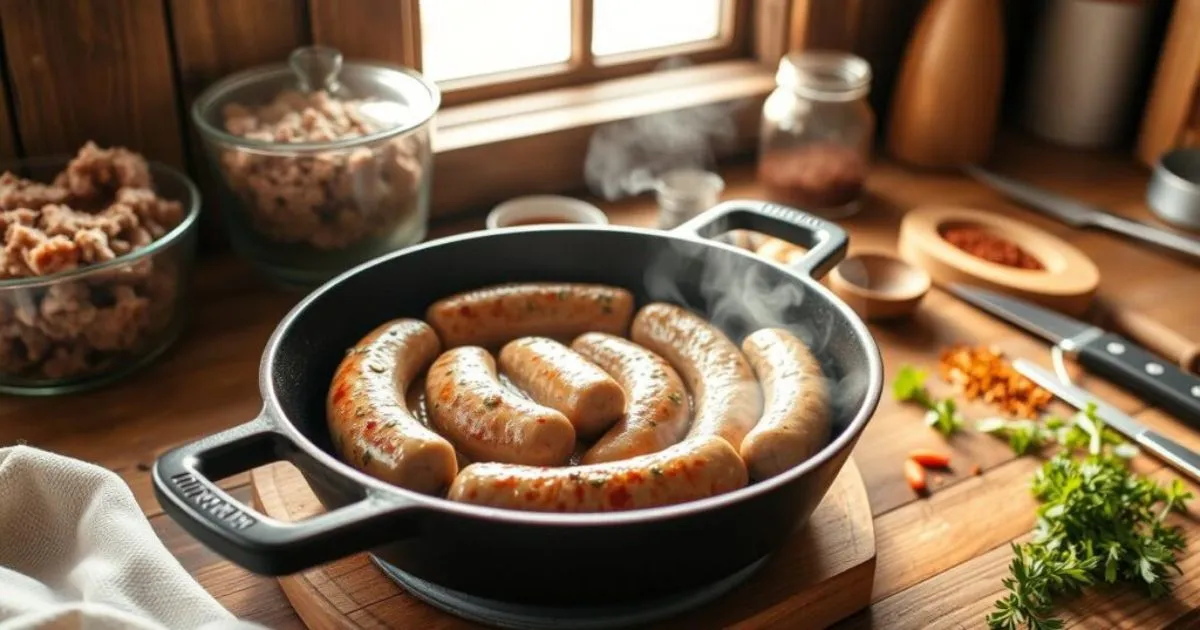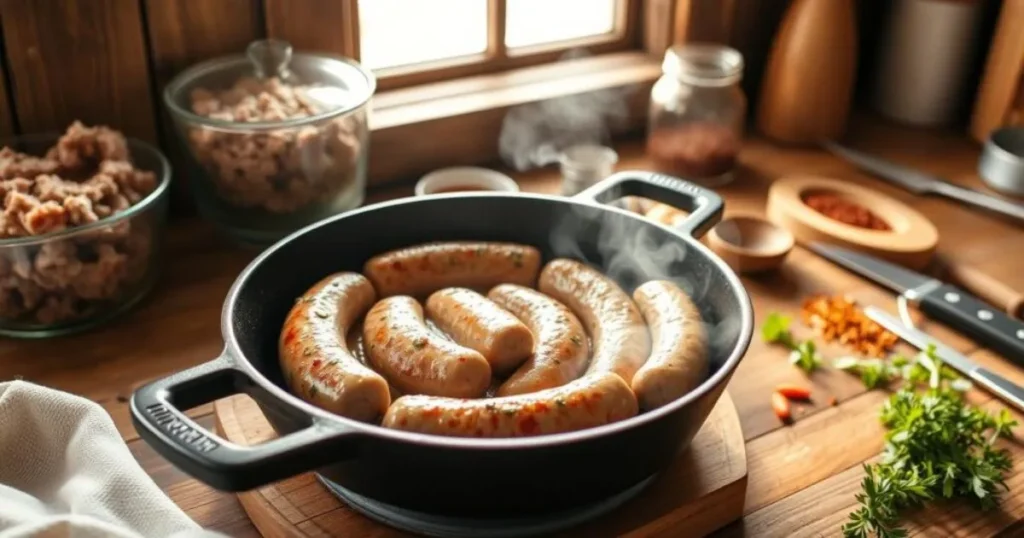How to Make Breakfast Sausage at Home

As the sun peeked through my kitchen window, the smell of freshly cooked sausages filled the air. It brought back memories of my grandmother’s breakfast table. Her homemade sausages were a family tradition I’ve kept alive.
Now, it’s your turn to make these savory morning delights at home. In this guide, you’ll learn how to make homemade breakfast sausage. It will turn your mornings into a feast of flavors that will nourish your soul.
Whether you’re a seasoned cook or new to sausage making, this article has you covered. You’ll learn how to make the perfect morning protein and savory breakfast links. They’ll become the highlight of your family’s breakfast.

Table of Contents
Understanding Breakfast Sausage Basics
Breakfast sausages are a key part of brunch, offering a tasty start to the day. You can choose from pork sausage patties or sizzling sausage links. These options add flavor to your morning meal.
Different Types of Breakfast Sausage
There are many types of breakfast sausages, each with its own taste:
- Pork Sausage Patties: These are made from ground pork and spices. They’re a favorite for breakfast.
- Sizzling Sausage Links: Made from pork and beef, these links are juicy and full of flavor.
- Turkey Sausage: A leaner choice, turkey sausage tastes like traditional pork sausages but is healthier.
- Chicken Sausage: A healthier option, chicken sausages are tender and have a light flavor.
Essential Equipment for Sausage Making
To make your own sausages, you’ll need some basic tools:
- Meat Grinder: This is key for grinding the meat finely for your sausage.
- Sausage Stuffer: It helps shape the sausage mixture into links or patties.
- Mixing Bowl: A big, strong bowl is needed for mixing the meat and seasonings.
- Thermometer: It’s important to check the sausage’s internal temperature for safety and taste.
Key Ingredients Overview
The main ingredients for breakfast sausage are:
| Ingredient | Purpose |
|---|---|
| Ground Pork | The main meat, giving the sausage its flavor and texture. |
| Spices and Herbs | Seasonings like sage and thyme add to the sausage’s taste. |
| Salt | It enhances the flavor and helps in curing. |
| Fat | Pork fat keeps the sausages juicy and flavorful. |
Knowing about breakfast sausage types, needed tools, and main ingredients helps you make tasty homemade sausages. These will make your brunch even better.
Selecting the Right Cut of Pork for Homemade Sausages
When making your own farm-fresh pork sausage or hearty breakfast sausage patties, the pork quality matters a lot. Choosing the right cuts is key to getting the perfect texture, flavor, and juiciness in your sausages.
Let’s look at the best pork cuts for making sausages:
- Pork Shoulder (Boston Butt): This cut is great for sausages, offering a mix of lean meat and tasty fat. The fat in the pork shoulder makes the sausage moist and tender.
- Pork Belly: Pork belly is rich, juicy, and full of flavor. It’s a favorite in many sausage recipes because of its high fat content, making the sausage feel luxurious in your mouth.
- Pork Loin: Pork loin is leaner but can still be used for farm-fresh pork sausage. To keep the sausage moist, mix it with a fattier cut like pork shoulder.
“The secret to juicy, flavorful sausages lies in the perfect balance of lean meat and fat.”
When picking your pork, aim for a 30% fat to 70% lean ratio. This mix ensures your hearty breakfast sausage patties are moist, tender, and full of flavor.
The quality of your pork is very important. Choose fresh, high-quality farm-fresh pork sausage from a trusted source for the best results. With the right pork, you’re on your way to making delicious homemade sausages that will wow your family and friends.
Essential Spices and Seasonings for Perfect Breakfast Sausage
Making tasty maple-flavored breakfast meats and smoky breakfast sausages at home is all about seasoning. The right mix of spices and herbs can turn regular pork into a breakfast treat.
Traditional Seasoning Combinations
Classic breakfast sausage recipes use simple, trusted seasonings. Here’s a basic mix to get you started:
- Sage
- Black pepper
- Salt
- Thyme
- Fennel seed
Modern Flavor Variations
But, modern cooks like to try new flavors. Here are some fresh takes on sausage seasoning:
- Maple and cayenne for a sweet-and-spicy mix
- Smoked paprika and garlic for a smoky taste
- Rosemary and lemon zest for a bright flavor
Measuring and Mixing Spices
Getting the spice ratio right is crucial for balanced flavor. Use about 1-2 teaspoons of seasoning per pound of pork. Mix the spices well to spread the flavors evenly.
By trying out different spice mixes, you can make amazing maple-flavored breakfast meats and smoky breakfast sausages. They’ll wow your family and friends.
Step-by-Step Meat Preparation Process
Making delicious pork sausage patties or tasty farm-fresh pork sausage begins with preparing the meat right. Follow this guide to get your pork ready for sausage making.
- Trim the Pork: Start by removing any extra fat, sinew, or connective tissue from your pork. This makes your sausage more even in texture.
- Cut into Cubes: Use a sharp knife to cut the pork into 1-inch cubes. This size is perfect for grinding later.
- Chill the Meat: Put the cubed pork in the freezer for 15-20 minutes. This makes the meat firmer, easier to grind, and keeps it cool.
- Weigh and Record: Weigh the pork and note the total weight. This is important for adding the right amount of seasonings and ingredients.
By following these steps, you’ll have your pork sausage meat ready for the next part of sausage making. Always handle the meat gently and keep it cold to keep its quality and flavor.

“Proper meat preparation is the foundation for creating truly exceptional pork sausage patties and farm-fresh pork sausage.”
Grinding and Mixing Techniques for Juicy Sausages
Making tasty hearty breakfast sausage patties or morning protein-packed links is all about grinding and mixing right. These steps are key to getting the perfect sausage texture and flavor.
Proper Grinding Temperature
The temperature when you grind your sausage meat is very important. Keeping it between 32°F to 40°F (0°C to 4°C) helps keep the meat juicy. It prevents it from becoming too dense or dry.
Mixing Methods for Optimal Texture
Mixing the ingredients well is crucial for even seasoning. Mixing by hand or with a stand mixer helps get a smooth texture. This way, the meat stays juicy and feels great in your mouth.
| Grinding Temperature | Mixing Method | Desired Texture |
|---|---|---|
| 32°F to 40°F (0°C to 4°C) | Gentle hand mixing or stand mixer with paddle attachment | Smooth, cohesive, and juicy |
By focusing on the right grinding temperature and mixing, your homemade sausages will always be moist and full of flavor. They’ll also have the perfect texture.
Forming Perfect Sausage Patties and Links
Making savory breakfast links or sizzling sausage links at home is rewarding. But, shaping the sausage mixture into patties or links can be tricky. We’ll share tips to help you make uniform homemade breakfast sausages.
Shaping Sausage Patties
To make round, even-sized patties, divide your sausage mixture into equal parts. Roll each part into a ball and then flatten it into a thin disk. Try to make them about 1/4 to 1/2 inch thick for even cooking.
Forming Sausage Links
- Prepare your sausage casing, if using. Natural casings or collagen casings work well for breakfast sausage links.
- Carefully fill the casing, leaving a small amount of space at the end to allow for expansion during cooking.
- Twist or pinch the casing at regular intervals to create individual links, typically around 4-6 inches long.
- Use a sharp knife to cut between the twists, separating the links.
| Sausage Shaping Technique | Pros | Cons |
|---|---|---|
| Sausage Patties | – Faster and easier to shape – Convenient for cooking | – May lose some juiciness compared to links |
| Sausage Links | – More traditional sausage shape – Retains moisture and texture better | – More time-consuming to form |
Choose your shape wisely. Handle the sausage mixture gently to avoid overworking it. With practice, you’ll soon be making perfect savory breakfast links and sizzling sausage links!
Tips for Achieving the Right Texture and Moisture
Making the perfect breakfast sausage is about finding the right mix of texture and moisture. To get your homemade sausages just right, follow these key tips.
Fat-to-Meat Ratio Guidelines
The best fat-to-meat ratio for juicy breakfast sausage is usually 20-30% fat. This makes your moist pork sausage smooth and easy to spread. But, the perfect ratio can change based on the pork you use and what you like.
Moisture Control Techniques
- Don’t over-mix the sausage. This can make it tough and dry.
- Add ice water or chilled broth to keep it moist.
- Cook the sausages at a moderate heat. High heat can dry out the outside too fast.
- Use a bit of binder, like breadcrumbs or egg, to keep moisture in while cooking.
By using these tips, you can make homemade breakfast sausages that are both juicy and delicious.
“The key to a great breakfast sausage is finding the right balance between the savory flavors and a satisfying, juicy texture.”
Storage and Preservation Methods
Keeping your homemade breakfast sausage fresh and tasty is key for a great brunch meat options experience. The right storage methods can make your sausages last longer and stay juicy. Here are the best ways to keep your homemade breakfast sausage in top shape.
Refrigeration for Short-Term Storage
Storing homemade breakfast sausage in the fridge is easy. Uncooked sausages can stay fresh for 3-4 days. Cooked sausages also last 3-4 days. Always wrap them tightly in plastic wrap or use an airtight container to avoid drying out.
Freezing for Long-Term Storage
Freezing is great for keeping your sausages for longer. Uncooked homemade breakfast sausage can be frozen for up to 3 months. Cooked sausages can be frozen for up to 2 months. Wrap each sausage individually or in small groups, then put them in a freezer-safe bag or container. Good packaging helps prevent freezer burn and keeps the sausage quality high.
| Storage Method | Uncooked Sausage | Cooked Sausage |
|---|---|---|
| Refrigerator | 3-4 days | 3-4 days |
| Freezer | Up to 3 months | Up to 2 months |
Using the right storage and preservation methods will keep your homemade breakfast sausage fresh and tasty. This way, you can enjoy your brunch meat options for a longer time.

Common Mistakes to Avoid When Making Breakfast Sausage
Making perfect homemade breakfast sausage needs skill and care. Stay away from these common mistakes to get sausages that are tasty, juicy, and just right.
Temperature Control Issues
Keeping the right temperature is key. Too hot and the meat gets dry and crumbly. Too cold and it doesn’t cure right, which can be unsafe. Watch your grinding, mixing, and cooking temps to get the right feel.
Seasoning Errors
- Under-seasoning: Sausages that are too plain miss the mark. Use plenty of seasoning.
- Over-seasoning: Too much spice can hide the pork’s natural taste. Measure your seasonings carefully.
- Unbalanced flavors: Missing the mix of sweet, savory, and spicy can make sausages taste flat.
Texture Problems
- Coarse grind: Meat that’s too coarse can make sausages feel grainy.
- Overworking the mixture: Too much mixing can make sausages dense and rubbery.
- Insufficient fat content: Not enough fat makes sausages dry and crumbly.
Mastering temperature, seasoning, and texture will help you make breakfast sausage tips that are top-notch. Steer clear of these sausage-making pitfalls to make sausages that everyone will love.
“The secret to perfect homemade breakfast sausage lies in the details. Pay attention to every step, and your efforts will be rewarded with sausages that are truly worth waking up for.”
Cooking Methods for Homemade Breakfast Sausage
Try different ways to cook your homemade breakfast sausages. For a crispy outside and a sizzling sound, pan-fry them on the stovetop. Or, get a smoky taste by grilling them over an open flame, on a grill or in a cast-iron skillet.
Baking is also a great choice. It lets you cook a big batch without needing to watch them all the time.
Make sure your sausages get to 160°F to be fully cooked and safe. Serve them with scrambled eggs, hash browns, and orange juice for a delicious breakfast.
Find the best way to cook your sausages for your family. Do they like the sizzling links or the smoky grilled taste?
FAQ
What are the different types of breakfast sausage?
There are many types of breakfast sausages. You can find pork sausage patties, savory links, maple-flavored sausages, and smoky ones. The choice depends on what you like and the flavor you want.
What equipment do I need to make homemade breakfast sausage?
To make homemade breakfast sausage, you need a meat grinder and a sausage stuffer for links. You’ll also need a mixing bowl and tools like a sharp knife, cutting board, and scale.
What are the key ingredients in breakfast sausage?
Breakfast sausage is made with ground pork, salt, pepper, and spices. You might add sage, thyme, fennel, and maple syrup for a sweet flavor.
How do I choose the right cut of pork for homemade sausage?
For homemade sausage, use a mix of pork shoulder and belly. This mix gives the sausage flavor, moisture, and juiciness.
What are some traditional seasoning combinations for breakfast sausage?
Traditional sausage seasoning includes sage, thyme, black pepper, and a bit of brown sugar or maple syrup. Modern recipes might add smoked paprika, fennel, or a hint of cayenne for a kick.
How do I properly grind and mix the sausage meat?
Keep the meat at about 40°F when grinding to avoid warming it too much. Mix well after grinding to spread the seasonings evenly.
What’s the best way to shape breakfast sausage patties and links?
For patties, shape the sausage on a lightly oiled or floured surface. For links, use a sausage stuffer and twist the filled casings into links.
How do I achieve the perfect texture and moisture in my homemade breakfast sausage?
Use a 70% lean pork to 30% fat ratio for juicy sausage. Adding ice water or broth helps keep the sausage moist and tender.
How should I store and preserve my homemade breakfast sausage?
Store fresh sausage in the fridge for 3-4 days. Freeze for months if you want to keep it longer. Make sure to package it well to avoid freezer burn.
What are some common mistakes to avoid when making breakfast sausage at home?
Avoid not keeping the right temperature during grinding, over-seasoning, and texture issues. Paying attention to these details will help you make great sausage.
What are the best cooking methods for homemade breakfast sausage?
You can cook homemade sausage in a pan, on the grill, in the oven, or air fryer. The goal is to cook it well without losing its juiciness and flavor.
Tell us how u found this recipe?
There are no reviews yet. Be the first one to write one.






